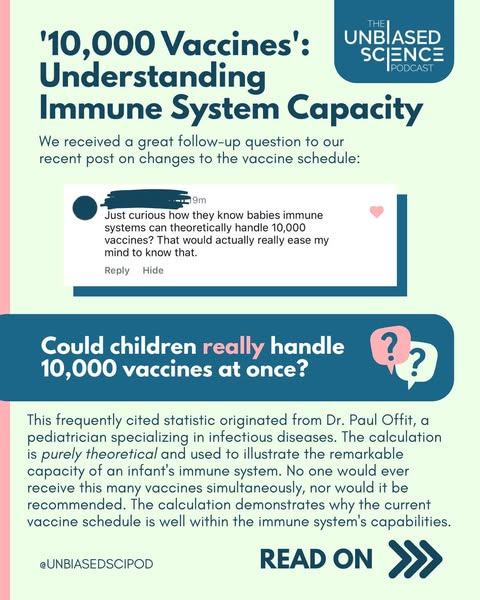Seeing Through Sears: What Parents Need to Know About 'The Vaccine Book’
Delaying Vaccines Delays Protection
As parents, we naturally want to make the best decisions for our children's health. When it comes to vaccines, it's completely understandable to have questions. What's in them? Are they necessary? What are the risks and benefits? These concerns are valid, and seeking information is part of being a responsible parent.
One resource that many parents have turned to is Dr. Bob Sears' "The Vaccine Book." At first glance, it appears to offer exactly what concerned parents are looking for—detailed information about vaccines to help guide their decisions. However, as both parents and scientists, we feel it's important to examine what this book actually recommends and what the science tells us about those recommendations. Let’s discuss…
When "Alternative" Means Delayed Protection
Dr. Sears' book doesn't outright oppose vaccination, but it suggests spreading vaccines out over a longer period, giving fewer vaccines at each doctor's visit. This "alternative schedule" approach might sound like a careful, measured compromise.
The reality is more concerning. This approach was actually pioneered by Dr. Sears himself and has become popular since his book's publication. The official vaccination schedule in the US wasn't established until 1995, making the concept of deliberately altering it a relatively recent phenomenon.
The delayed approach might feel safer to anxious parents, but it leaves children vulnerable to serious infectious diseases for longer periods of time.
Where the Science Doesn't Support the Claims
Healthcare professionals have been largely critical of Dr. Sears' positions, and for good reason. In a detailed 2009 analysis by Dr. Paul Offit and Charlotte Moser, several problematic claims in "The Vaccine Book" were identified:
Misusing Safety Data: The book presents reports from VAERS (Vaccine Adverse Event Reporting System) as evidence that vaccines cause specific problems. However, VAERS is a passive surveillance system where anyone can report anything that happens after vaccination. It's designed to flag potential issues for investigation, not to prove that vaccines caused those issues. In fact, most problems reported to VAERS are not found to be caused by vaccines. And the small percentage that are found to be related are usually well-known or expected reactions (such as local or allergic reactions).
Downplaying Disease Risks: Dr. Sears discusses his own experience of rarely seeing certain diseases as evidence that they're not worth protecting against. This reasoning misses a crucial point: he rarely sees these diseases precisely because vaccines have made them rare. It's like arguing that seatbelts aren't necessary because you rarely see car accident victims in your daily life.
Aluminum Concerns: Dr. Sears presents aluminum in vaccines as inherently dangerous, feeding into fears that many parents have about "injecting" aluminum versus consuming it through food. Here's what the science actually shows:
Experts at the Children's Hospital of Philadelphia (CHOP) explain that aluminum is the most abundant metal on Earth. It’s found in many foods and drinks, medications, and even pots and pans. Some vaccines contain small amounts of aluminum to help boost the immune response and allow for lower doses of vaccine to be used. The total aluminum exposure from vaccines is very low, even lower than daily dietary exposure. Infants receive approximately 4 milligrams of aluminum from vaccines in their first six months of life, while formula-fed babies consume about 117 milligrams from formula alone during the same period. Even breastfed babies consume about 7 milligrams of aluminum in that time.
While most aluminum from foods passes right through the intestine without getting into the blood, most aluminum from a vaccine gets into the blood but then leaves the body in the urine soon after. Half is removed within a day. Most is gone within a couple of weeks. The CHOP experts point out that by the time children become adults, the tiny amount of aluminum that remains in the body has actually come from food and not vaccines. The aluminum in vaccines is also in an insoluble form that is absorbed slowly over time from the injection site, and our blood-brain barrier prevents aluminum from reaching the brain in any significant quantity. Safety studies spanning 70 years have consistently shown that aluminum adjuvants in vaccines are safe, and when researchers measured aluminum levels in blood after vaccination, they found no increase resulting from the vaccines.
The "Overwhelming the Immune System" Myth: One of Dr. Sears' core premises is that giving multiple vaccines at once might "overwhelm" a child's immune system. Given how widely this idea has spread on social media, it’s understandable that some parents might be concerned or confused. But those fears don’t match what we know about how robust children's immune systems actually are or how the immune system actually works.
Dr. Paul Offit and his colleagues addressed this concern directly in a landmark 2002 study published in Pediatrics. They calculated that even if a child received 10,000 vaccines simultaneously, it would use only about 0.1% of their immune system's capacity. To put this in perspective, the 11 routinely recommended childhood vaccines (including the COVID-19 vaccine) contain only 180-320 antigens combined (an antigen is the part of the vaccine that triggers the immune system response).
The reality is that children's immune systems are remarkably capable. From the moment they're born, babies encounter thousands of bacteria, viruses, and other microbes daily. A simple trip to the playground exposes them to more bacterial and viral challenges than they'll ever encounter in vaccines. Studies suggest that early exposure to dirt may reduce kids' risk of developing allergies and autoimmune conditions, and research shows that children who played in forest soil had more diverse collections of harmless bacteria on their skin and more immune-regulatory cells in their blood within just one month than those who didn’t play in the soil.
The Autism Myth That Won't Die: Perhaps most troubling of all, Dr. Sears perpetuates the thoroughly debunked claim that vaccines cause autism. This isn't just scientifically wrong—it's actively harmful to both children with autism and public health.
The evidence against any vaccine-autism link is overwhelming and definitive. A comprehensive 2014 meta-analysis examining five cohort studies involving 1,256,407 children and five case-control studies involving 9,920 children found no relationship whatsoever between vaccination and autism. The analysis specifically looked at MMR vaccines, thimerosal, and mercury exposure—none showed any association with autism development.
Study after study has reached the same conclusion. A 2015 JAMA study of over 95,000 children, including 2,000 at high risk for autism because they had siblings with the condition, found no increased risk. Research published in the Annals of Internal Medicine in 2019, following 650,000 Danish children for over a decade, confirmed the same result.
The original 1998 study by Andrew Wakefield that started this myth has been thoroughly discredited. The paper was retracted from The Lancet, Wakefield lost his medical license for falsifying data, and investigations revealed he had financial conflicts of interest. The study involved only 12 children and had no control group—it couldn't prove causation even if it had been conducted honestly.
We know autism begins developing in the womb, long before any vaccines are given. Home movie studies show that trained specialists can identify subtle signs of autism in children as young as one year old, before they receive the MMR vaccine. When children are exposed to rubella during pregnancy, they have increased autism risk, but exposure after birth shows no such association.
For Dr. Sears to continue promoting the vaccine-autism myth in his 2023 book, decades after it has been thoroughly debunked by numerous large-scale studies, is scientifically indefensible and ethically troubling. It perpetuates stigma against people with autism by suggesting their condition is a "vaccine injury" rather than a neurological difference with genetic and developmental origins.
The Real-World Consequences
When vaccination is delayed, children remain vulnerable to serious diseases. We're seeing this play out in real time with measles outbreaks. Current CDC data shows that almost all measles cases in 2025 (96%) occurred in people who did not receive the MMR vaccine. These aren't just statistics—they represent children suffering from preventable diseases, families dealing with serious illness, and communities grappling with outbreaks that could have been avoided.
Red Flags That Raise Concerns
While Dr. Sears claims he isn't anti-vaccine, his associations tell a different story. He’s built a lucrative brand by packaging false health claims as truth and selling them to a trusting audience. His website prominently features his membership in "Physicians for Informed Consent," an organization that misrepresents vaccine safety data. He also promotes Children's Health Defense and the National Vaccine Information Center—both organizations known for spreading vaccine misinformation, including false claims about autism links and misuse of VAERS data.
Dr. Sears also hosts a podcast that frames vaccines negatively and asks leading questions designed to instill doubt rather than provide balanced information. His other book, "The Autism Book," explicitly promotes the false claim that vaccines cause autism and suggests that children with autism shouldn't be vaccinated.
Professional Accountability
The medical community has taken notice of Dr. Sears' practices. In 2024, the Medical Board of California placed him on 35-month probation for "repeated negligence in his care and failure to maintain adequate and accurate records." Specifically, he wrote vaccine exemption letters without properly determining if children had genuine medical contraindications to vaccination. This followed an earlier disciplinary order in 2018.
Moving Forward as Informed Parents
As parents, our instinct to question and research what goes into our children's bodies is not only natural—it's admirable. The key is ensuring we're getting our information from reliable sources that present the full picture, not selectively chosen data that supports a predetermined conclusion.
When evaluating vaccine information, look for sources that:
Present the actual research, not just cherry-picked studies
Acknowledge both benefits and risks honestly
Don't use fear-based language or leading questions
Are transparent about their funding and associations
Your pediatrician, the CDC, and the American Academy of Pediatrics are excellent starting points for evidence-based vaccine information. They can help you understand not just what vaccines your child needs, but why the timing matters for optimal protection.
Being a questioning parent doesn't mean delaying protection for our children—it means asking the right questions and seeking answers from sources committed to their health and safety. Our children deserve nothing less than decisions based on the best available science, delivered with the love and care that drives every choice we make for them.
Stay Curious,
Unbiased Science
P.S. Want to support our work? The best way is to subscribe to our Substack and share our content. While all our articles are always completely free to read, paid subscriptions help sustain our in-depth reporting on public health and science topics. Thank you for considering it!
Major thanks to Nicholas Viall on the Unbiased Science team for putting together a thorough literature review that provided the backbone for this article!













Another excellent article from the Unbiased Science team. I hope it's disseminated widely. My wife and I certainly considered the pros and cons of vaccinations when our son was born but, for us, the evidence is overwhelmingly in favor of do rather than don't vaccinate.
What I am continually amazed by is the fundamental foundation of genetic heritabilty data that is overlooked when discussing the etiology of ASD. While the Online Mendelian Inheritance In Man [OMIM] database from Johns Hopkins Medical School attempts to categorize every instance and occasion of a potential marker - some 139 - the single general category of Autism should be easily identifiable to every clinician and parent by its description.
And amazingly, the studies that began to define ASD began with a paper written, first, by Dr. Leo Kanner, "Autistic Disturbances of Affective Contact" in 1943, followed by a similar paper by Dr. Hans Asperger in 1944. And you would have thought they were dealing with a completely opposing entity: Kanner wrote of a group, "A majority [of which] are retarded, often severely; a significant proportion have seizures and may have “soft” neurological signs and symptoms—a whole range of repetitive or automatic movements, such as spasms, tics, rocking, spinning, finger play, or flapping of the hands; problems of coordination and balance; peculiar difficulties, sometimes, in initiating movements, akin to what is seen in parkinsonism," while Asperger spoke of children who "might have certain positive or compensating features— particular originality of thought and experience, which may well lead to exceptional achievements in later life.” And this is critical, as the OMIM is every bit as much focused on heritable behavioral diversity as it is on specific genetic heritability.
Nevertheless, serving as a base, the OMIM focuses on what you would expect for Mendelian inheritance: classic family pedigree studies (including Scandinavian studies that rely on familial pedigrees dating to the 17th century); validated twin studies; genetic heterogeneity (e.g. genome wide association studies); exclusion studies; molecular genetics; and populalation genetics. In our day, study after study confirms the indisputable fact that genetics are seen to influence the development of ASD in anywhere from 40-80% of cases, and we have only begun to investigate the epigenetic influences - currently believed to include later-in-life parenthood,; an over/under abundance of critical nutrients during pregnancy; disturbance in the brain/gut microbiome; and other yet to be discovered triggers may be triggers for ASD.
As a psychiatrist, I have long thought that the avoidance of this genetic fact is a distraction for what I have been reading in the research literature regarding the fear of being viewed as a "bad" or "negligent" parent for having an ASD child - and I believe you would very surprised by the sheer number of research studies that bear this out. I have concluded I need to be sensitive, empathetic, and supportive and I am trying to lose my "combative" mode!